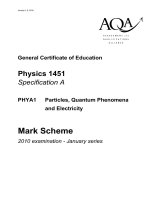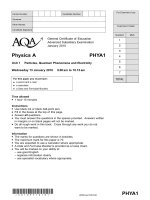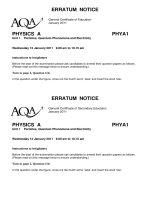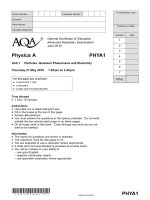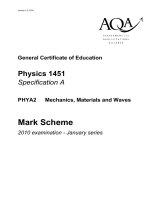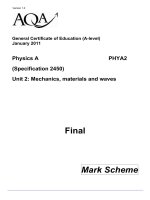- Trang chủ >>
- Khoa Học Tự Nhiên >>
- Vật lý
Vật lý A level: AQA PHYA4 w MS JAN12
Bạn đang xem bản rút gọn của tài liệu. Xem và tải ngay bản đầy đủ của tài liệu tại đây (189.69 KB, 8 trang )
Version 1.0
General Certificate of Education (A-level)
January 2012
Physics A
(Specification 2450)
PHYA4
Unit 4: Fields and further mechanics
Final
Mark Scheme
Mark schemes are prepared by the Principal Examiner and considered, together with the
relevant questions, by a panel of subject teachers. This mark scheme includes any
amendments made at the standardisation events which all examiners participate in and is the
scheme which was used by them in this examination. The standardisation process ensures
that the mark scheme covers the students’ responses to questions and that every examiner
understands and applies it in the same correct way. As preparation for standardisation each
examiner analyses a number of students’ scripts: alternative answers not already covered by
the mark scheme are discussed and legislated for. If, after the standardisation process,
examiners encounter unusual answers which have not been raised they are required to refer
these to the Principal Examiner.
It must be stressed that a mark scheme is a working document, in many cases further
developed and expanded on the basis of students’ reactions to a particular paper.
Assumptions about future mark schemes on the basis of one year’s document should be
avoided; whilst the guiding principles of assessment remain constant, details will change,
depending on the content of a particular examination paper.
Further copies of this Mark Scheme are available from: aqa.org.uk
Copyright © 2012 AQA and its licensors. All rights reserved.
Copyright
AQA retains the copyright on all its publications. However, registered schools/colleges for AQA are permitted to copy material
from this booklet for their own internal use, with the following important exception: AQA cannot give permission to
schools/colleges to photocopy any material that is acknowledged to a third party even for internal use within the centre.
Set and published by the Assessment and Qualifications Alliance.
The Assessment and Qualifications Alliance (AQA) is a company limited by guarantee registered in England and Wales (company number 3644723) and a registered
charity (registered charity number 1073334).
Registered address: AQA, Devas Street, Manchester M15 6EX.
Mark Scheme – General Certificate of Education (A-level) Physics A – PHYA4 – January 2012
3
Instructions to Examiners
1 Give due credit for alternative treatments which are correct. Give marks for what is correct in
accordance with the mark scheme; do not deduct marks because the attempt falls short of
some ideal answer. Where marks are to be deducted for particular errors, specific instructions
are given in the marking scheme.
2 Do not deduct marks for poor written communication. Refer the scripts to the Awards meeting
if poor presentation forbids a proper assessment. In each paper, candidates are assessed on
their quality of written communication (QWC) in designated questions (or part-questions) that
require explanations or descriptions. The criteria for the award of marks on each such
question are set out in the mark scheme in three bands in the following format. The descriptor
for each band sets out the expected level of the quality of written communication of physics for
each band. Such quality covers the scope (eg relevance, correctness), sequence and
presentation of the answer. Amplification of the level of physics expected in a good answer is
set out in the last row of the table. To arrive at the mark for a candidate, their work should first
be assessed holistically (ie in terms of scope, sequence and presentation) to determine which
band is appropriate then in terms of the degree to which the candidate’s work meets the
expected level for the band.
QWC descriptor mark range
Good - Excellent
see specific mark scheme 5-6
Modest - Adequate
see specific mark scheme 3-4
Poor - Limited
see specific mark scheme 1-2
The description and/or explanation expected in a good answer should include a
coherent account of the following points:
see specific mark scheme
Answers given as bullet points should be considered in the above terms. Such answers
without an ‘overview’ paragraph in the answer would be unlikely to score in the top band.
3 An arithmetical error in an answer will cause the candidate to lose one mark and should be
annotated AE if possible. The candidate’s incorrect value should be carried through all
subsequent calculations for the question and, if there are no subsequent errors, the candidate
can score all remaining marks.
4 The use of significant figures is tested once on each paper in a designated question or part-
question. The numerical answer on the designated question should be given to the same
number of significant figures as there are in the data given in the question or to one more than
this number. All other numerical answers should not be considered in terms of significant
figures.
5 Numerical answers presented in non-standard form are undesirable but should not be
penalised. Arithmetical errors by candidates resulting from use of non-standard form in a
candidate’s working should be penalised as in point 3 above. Incorrect numerical prefixes and
the use of a given diameter in a geometrical formula as the radius should be treated as
arithmetical errors.
6 Knowledge of units is tested on designated questions or parts of questions in each a paper.
On each such question or part-question, unless otherwise stated in the mark scheme, the
mark scheme will show a mark to be awarded for the numerical value of the answer and a
further mark for the correct unit. No penalties are imposed for incorrect or omitted units at
intermediate stages in a calculation or at the final stage of a non-designated ‘unit’ question.
7 All other procedures including recording of marks and dealing with missing parts of answers
will be clarified in the standardising procedures.
Mark Scheme – General Certificate of Education (A-level) Physics A – PHYA4 – January 2012
4
GCE Physics, Specification A, PHYA4, Fields and Further Mechanics
Section A
This component is an objective test for which the following list indicates the correct answers used in
marking the students’ responses.
Keys to Objective Test Questions
1 2 3 4 5 6 7 8 9 10 11 12 13
A D C C B D A A D C B B A
14 15 16 17 18 19 20 21 22 23 24 25
D C D C D D B B A B C A
Section B
Question 1
a
work done [or energy needed] per unit charge [or (change in) electric pe
per unit charge]
3
on [or of] a (small) positive (test) charge
in moving the charge from infinity (to the point) [not from the point to
infinity]
b i
=
gives Q (=4π
ε
0
rV) = 4π × 8.85 × 10
−
12
× 0.30 × 3.0
3
= 1.0 × 10
−
10
(C)
to 2 sf only
b ii
use of V ∝
gives V
M
=
L
(= (+) 1.0 V)
1
b iii
=
=
. ×
×. ×
× .
(= 2.50 V m
–1
)
1
c i uniformly spaced vertical parallel lines which start and end on plates
2
relevant lines with arrow(s) pointing only downwards
c ii = 3.3(3) (V m
–1
)
1
c iii part (b) is a radial field whilst part (c) is a uniform field
1
[or field lines become further apart between L and M but are equally spaced
between R and S]
Total 12
Mark Scheme – General Certificate of Education (A-level) Physics A – PHYA4 – January 2012
5
Question 2
a charge (stored) per unit potential difference
2
[or C = Q/V where Q = charge (stored by one plate) V = pd (across
plates) ]
b i
=
=
. ×
.
= 2.2 × 10
–6
(F) (or 2.2 µF)
2
b ii
when t = time constant Q = 0.63 × 13.2 = 8.3
(µC)
2 [or = 0.63 × 13(.0) (from graph) = 8.2 (µC)]
reading from graph gives time constant = 15 (± 1) (ms)
b iii
resistance of resistor =
=
time constant
=
×
. ×
= 6820 (Ω)
1
b iv gradient = current
1
c i
maximum current =
=
=
.
= 0.88 (mA)
1
[or value from initial gradient of graph: allow 0.70 – 1.00 mA for this
approach]
c ii
curve starts at marked l
max
on l axis and has decreasing negative gradient
2
line is asymptotic to t axis and approaches ≈ 0 by t = 60 ms
Total 11
Question 3
a i
speed at P, v (=
2
) =
2 × 9.81 × 25
2
= 22(.1) (m s
–1
)
a ii
use of F = k∆L gives
=
=
× .
2
= 11 (10.5) (m)
b i
period T = 2π
= 2π
(= 6.51 s)
2
time for one half oscillation = 3.3 (3.26) (s)
b ii
frequency
=
=
.
(= 0.154 (Hz))
3
use of v = ± 2πf
when x = 10.5 m and v = 22.1 m s
–1
gives
22.1
2
= 4π
2
× 0.154
2
(A
2
– 10.5
2
)
from which A = 25.1 (m)
[alternatively, using energy approach gives ½ mv
P
2
+ mg∆L
= ½ k(∆L)
2
∴ (29 × 22.1
2
) + (58 × 9.81 × ∆L) = 27 (∆L)
2
solution of this quadratic equation gives ∆L = 35.7 (m)
from which A = 25.2 (m) ]
Mark Scheme – General Certificate of Education (A-level) Physics A – PHYA4 – January 2012
6
c bungee cord becomes slack
max 2
student’s motion is under gravity (until she returns to P)
has constant downwards acceleration or acceleration is not ∝ displacement
d i
when student is at R or at bottom of oscillation 1
d ii
at uppermost point or where it is attached to the railing
2
because stress = F/A and force at this point includes weight of whole cord
[accept alternative answers referring to mid-point of cord because cord will
show thinning there as it stretches or near knots at top or bottom of cord
where A will smaller with a reference to stress = F/A]
Total 14
Question 4
a i
use of
S
P
=
S
P
gives N
S
=
×
= 60 (turns)
1
a ii max output power = 0.85 × 0.630 × 230 (= 123 W)
2
max number of lamps
=
= 5 (no mark for non-integer answer)
[or efficiency =
S
S
P
P
gives 0.85 =
S
×
. ×
(and max I
S
= 10.3 (A))
max number of lamps
=
.
.
= 5 ]
a iii
fuse prevents transformer from overheating [or prevents transformer from
supplying excessive currents]
1
a iv
(all of) transformer is disconnected from supply when fuse fails [or fuse in
secondary circuit would leave primary circuit live]
1
Mark Scheme – General Certificate of Education (A-level) Physics A – PHYA4 – January 2012
7
b i
The candidate’s writing should be legible and the spelling, punctuation
and grammar should be sufficiently accurate for the meaning to be
clear.
max 6
The candidate’s answer will be assessed holistically. The answer will be
assigned to one of three levels according to the following criteria.
High level (good to excellent) 5 or 6 marks
The information conveyed by the answer is clearly organised, logical and
coherent, using appropriate specialist vocabulary correctly. The form and
style of writing is appropriate to answer the question.
The candidate states that the ac in the coil produces a constantly changing
magnetic field that passes through the ring, causing an emf to be induced
according to Faraday’s law.
The candidate recognises that the induced emf will cause a current to flow
in the ring, that the current is likely
be large because the coil acts as a single
conductor with low resistance, and that this current also produces a
magnetic field.
The candidate appreciates that Lenz’s law indicates that the direction of the
induced current is such as to produce a magnetic field that will oppose the
existing field, and that the two fields will interact.
The candidate refers to the force that acts on a current-carrying conductor
when it is in a magnetic field and that this force lifts the ring upwards (into
an area where the magnetic field is weaker) until the upwards magnetic
force is equal to the downwards weight of the ring.
Intermediate level (modest to adequate) 3 or 4 marks
The information conveyed by the answer may be less well organised and
not fully coherent. There is less use of specialist vocabulary, or specialist
vocabulary may be used incorrectly. The form and style of writing is less
appropriate.
The candidate is familiar with either or both Faraday’s and Lenz’s laws but
only applies one of them to explain what happens in this demonstration.
There are correct references to the two forces that act on the ring, and a
reasonable explanation of why the ring reaches a stable position.
Low level (poor to limited) 1 or 2 marks
The information conveyed by the answer is poorly organised and may not
be relevant or coherent. There is little correct use of specialist vocabulary.
The form and style of writing may be only partly appropriate.
The candidate refers much more superficially to either Faraday’s or Lenz’s
law (or to both of them) but shows some understanding of why the forces
acting on the ring cause it to reach equilibrium.
Mark Scheme – General Certificate of Education (A-level) Physics A – PHYA4 – January 2012
8
The explanation expected in a competent answer should include a
coherent selection of the following points concerning the physical
principles involved and their consequences in this case.
Faraday’s law
• An emf is induced whenever there is a change in the magnetic flux
passing through a conductor.
• The magnitude of the emf is proportional to the rate of change of
magnetic flux linkage.
• The induced emf will cause a current to flow in any complete circuit,
such as a single conducting ring.
• Because the ring is made from aluminium, which is a good
conductor, a large initial current will be induced in it.
Lenz’s law
• The induced current flows in such a direction as to oppose the
increase in magnetic flux when the current is switched on in the coil.
• The current produces a magnetic field in the opposite direction to
that produced by the coil.
• These two (alternating) fields interact like the fields between two
facing like magnetic poles, giving repulsion.
Forces
• The ring is a current-carrying conductor in a magnetic field, and
consequently it experiences a force.
• This magnetic force acts upwards, in the opposite direction to the
weight of the ring.
• As the ring rises, the magnetic field to which it is exposed becomes
weaker as it moves away from the coil.
• This reduces the induced current, reducing also the magnetic force
on the ring.
• The ring reaches a stable height when the magnetic force has
decreased to the point where it is equal to the weight of the ring.
b ii
ring would ‘float’ higher [or be expelled upwards]
max 2
because (initial) current or emf (induced) in ring is greater
or ring moves into weaker field until magnetic force balances weight
[or (initially) magnetic force exceeds weight]
Total 13
UMS conversion calculator www.aqa.org.uk/umsconversion
